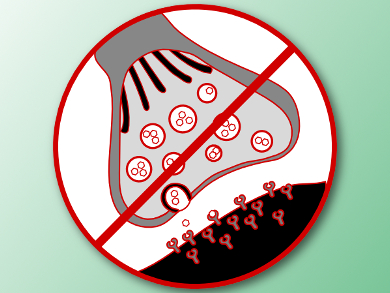N-methyl-D-aspartate (NMDA) receptors in the brain are important for learning and memory, and their overactivation plays a role in diseases, e.g., Alzheimer’s and Huntington’s disease. However, antagonists that block these receptors can have serious side effects such as hallucinations. NDMA receptors are found in different locations: inside synapses, where they are important for normal function, and outside of synapses, where their activation plays a part in pathological processes. Until now, antagonists cannot discriminate between NMDA receptor activity in synapses and outside of synapses.
Elena Molokanova, Nanotools Bioscience, Encinitas, CA, USA, and colleagues have developed an NMDA receptor antagonist that is simply too large to fit in the synaptic cleft and thus inhibits only extrasynaptic receptors. The synaptic cleft has an average size of 25 nm, and the team built a nanostructure with a diameter of roughly 35 nm. The hybrid drug consists of a gold nanoparticle core, a polymer linker, and memantine, an NMDA receptor antagonist. The compound contains about 50 molecules of memantine per nanoparticle.
The researchers tested the effects of the drug in vitro and found that it effectively inhibited extrasynaptic NMDA receptors, but had no influence on synaptic activity. Further studies showed that the hybrid drug can successfully penetrate brain tissue. The team hopes that further development of such rationally designed antagonists might result in new neuroprotective drugs. The drug design strategy could also be extended to other nanoparticle cores and active molecules.
- Nanostructured Antagonist of Extrasynaptic NMDA Receptors,
Alex Savchenko, Gary B. Braun, Elena Molokanova,
Nano Lett. 2016.
DOI: 10.1021/acs.nanolett.6b01988



